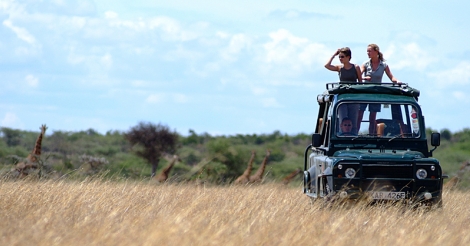With 23 National Parks and 15 National Reserves, it is no wonder why Kenya has always been a popular safari destination. But what really makes it one of the world’s best safari countries is the superiority of the quality of its parks and reserves. So if you’re heading to Kenya or planning to visit anytime soon, this lists the top Kenya wildlife parks and everything you need to know about them.
MASAI MARA NATIONAL RESERVE
Thanks to its incredible wildlife, “real Africa” scenery and yearly Great Migration, Masai Mara National Reserve is Kenya’s flagship safari park, the “Queen” of all parks and reserves in the country. On a normal day, The Mara showcases big families of elephants, buffaloes, lions, giraffes, and hippos among many more. It virtually contains every other type of wildlife found in Kenya and is also known for having the most approachable animals.
From July to October, millions of wildebeests, zebras and gazelles can be seen around the plains and also on the Mara River, crossing from the Serengeti while battling with all types of obstacles. The sheer amount of predators that tail them will also ensure your days are filled with once in a lifetime moments you are bound to remember for a lifetime. This event is the famous Great Migration, which happens every year and takes place in only 2 safari parks: Serengeti in Tanzania and Masai Mara in Kenya.
To add to any safari experience, the park also offers cultural tours like visiting the fascinating Maasai tribesmen.
Things To Know: The park is served by several scheduled flights making it not only easy to reach but also more affordable. There are also several landing strips in various locations so you are never too far from the action
Getting There: 40-minute Charter flights from Nairobi or you can also catch a flight from Tanzania (mind your travel papers for this). Another way is to let your tour guide organize a five-hour drive from Nairobi.
Best Time To Go: July to October
Other must-visit parks
- Lewa Wildlife Conservancy
- Aberdare National Park
- Mount Kenya National Park
- Meru National Park
- Ol Pejeta Conservancy
Certainly, the top Kenya wildlife parks offer some incredible adventures with the world’s most impressive animals. Its diverse landscapes and breathtaking sunsets also create lovely backdrops for any holiday.
AMBOSELI NATIONAL PARK
If you’ve seen postcards of Kenya or even Africa in general, it’s most likely that you’ve seen Amboseli National Park. It is often photographed with beautiful elephant herds against a stunning backdrop of the famous Mount Kilimanjaro, Africa’s highest peak.
Amboseli is centered around Observation Hill, which offers great views of the plains below. It hosts 50 mammal species and 400 bird species. The Maasai also live around the park and so do their cattle.
Getting There: By road from Nairobi (4 hours) or a daily scheduled flight from Nairobi’s Wilson Airport.
Best Time To Go: June to October
TSAVO NATIONAL PARK
Tsavo National Park is split into two: Tsavo East and Tsavo West. Together, these two national parks create the largest protected wildlife sanctuary in Kenya which spans to almost twenty times larger than Masai Mara. Since the vast park is located in the southeasternmost part of the country, it is known to be the least visited and wildest park in Kenya. In fact, due to its size, some parts of it are almost never visited (by humans) at all.
In comparison, Tsavo West is more developed but Tsavo East is more accessible. Home to the only red elephants in the world (they only appear red because of their constant dust bathing with fine red volcanic soil), Tsavo East features a vast dry plain and Galena River. It is also the only Kenyan park that permits night drives.
In Tsavo West, elephants are still visible sometimes even bathing among the hippos and the crocodiles. The best way to see this is from a unique vantage point of an under-water glass tank. The Big Five also live here although spotting them may be quite challenging. What stands out in Tsavo West is its diversity in landscape. It provides the option for exploring caves and seeing the Mzima Springs gushing out water onto the millions of years old lava fields
Fun Fact: Tsavo National Park makes up 4% of Kenya’s land mass
Best Time To Go: May to October
Getting There: By road from Mombasa (3-4 hours) or Nairobi (10 hours); Or by air via a charter flight. Tsavo East has no scheduled flights while Tsavo West does.
LAKE NAKURU NATIONAL PARK
Did you know that there are more than a million pink flamingoes that flock on the shallow shores of Lake Nakuru? These vibrant birds are joined by stunning groups of wildlife such as warthogs, zebras, giraffes, hippos, lions and white rhinos. The pink flamingoes, which are bright pink in color because of the algae they eat from the lake’s alkaline waters, are its major attraction. But what makes it even better and on top is that it is the only park where it’s almost impossible not to see a rhino (black or white).
Lake Nakuru sits very closely to Lake Naivasha. They are both in close proximity to the city center of Nairobi and thereby are deemed excellent day trips especially when combined in one trip.
To get to the park, you have to go through a Euphorbia forest which is a type of cactus-looking tree. This adds more uniqueness to the experience.
Fun Fact: Lake Nakuru is naturally drier than any other parks in Kenya and so even in wetter months, rainfall is low in Lake Nakuru.
How to Get There: Through a private vehicle or public transportation. The park is a three-hour drive from Nairobi.
Best Time To Go: Year-round
NAIROBI NATIONAL PARK
Just a stone’s throw away from the hustle and bustle of Kenya’s capital city, Nairobi National Park is “the ultimate wildlife experience within the metro.” It is most famous for its black rhino sanctuary but it has also made a notable reputation for its own wildebeest migration, superb avifauna, and exciting walking trails that offer visitors a chance to experience the African bush at its best.
Nairobi National Park features the Big Five sans the elephants which are the only large mammals not present in the park. Due to its proximity to the city, many visitors come here for a day tour only as it can already cover the best in the park. Others come with their own vehicle; others hire a guide at the gate, and some others just stay in the tented campsite instead of staying in hotels.
How to Get There: By road, it’s less than 5 miles from the city center.
Best Time To Go: Year-round but weather-wise, between June and September



0 Comment